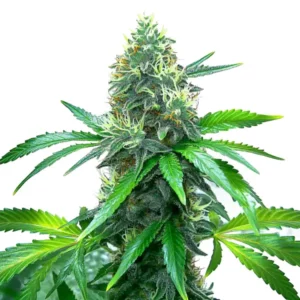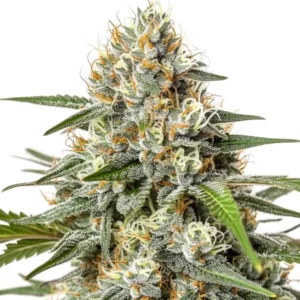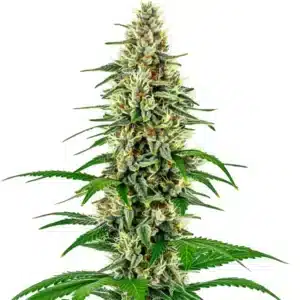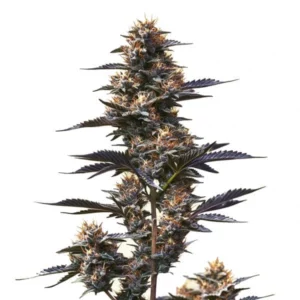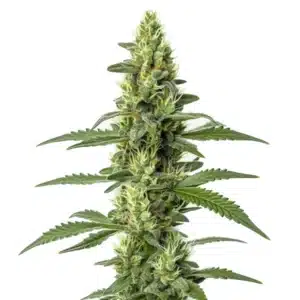
Knowing Cannabis Plant Physiology
Knowing cannabis plant physiology can elevate your growing game. This knowledge helps whether you’re buying seeds for the first time or have a few harvests under your belt. The cannabis plant anatomical structure is fascinating and complex, comprising roots, stems, leaves, and flowers, each playing a crucial part in the plant’s life cycle.
Roots anchor the plant and absorb water and nutrients. Stems provide support and transport essential elements throughout the plant. Leaves are the primary site for the cannabis photosynthesis process, converting light into energy. Flowers, especially the female ones, are where cannabinoid synthesis in cannabis takes place, leading to the production of THC, CBD, and other compounds.
Recommended Strains
Consider the strain Grape Ape for a robust experience. Its physiological traits make it a favorite among growers. The dense flower structure and vibrant leaves are a testament to its well-adapted physiological characteristics. Observing such strains can provide real-life examples of successful cannabis physiology.
Cannabis Photosynthesis Process
Photosynthesis is vital for cannabis plants, turning sunlight into food. This process occurs mainly in the leaves, which absorb light through chlorophyll. The light energy splits water molecules, releasing oxygen and creating energy-rich molecules like ATP and NADPH.
These molecules fuel the conversion of carbon dioxide into glucose, a sugar that feeds plant growth. The efficiency of the cannabis photosynthesis process directly impacts plant vigor and yield. Ensuring your plants receive ample light is key. For instance, indoor growers often use LED lights to mimic sunlight.
Knowing cannabis plant physiology involves mastering how the photosynthesis process can be optimized. Plants require a precise balance of light intensity and duration to maximize their photosynthetic capabilities. By fine-tuning these variables, growers can significantly enhance plant growth and overall health.
Environmental conditions such as humidity and temperature also affect photosynthesis. Maintaining ideal conditions can ensure that the process runs smoothly, leading to better energy production within the plant. This knowing highlights the interconnectedness of different physiological aspects in cannabis cultivation.
Optimizing Light for Photosynthesis
Providing adequate light is crucial for robust cannabis growth. Natural sunlight is ideal, but not always available year-round. Grow lights, such as LEDs or HPS, can supplement or replace sunlight, delivering the necessary spectrum for the cannabis photosynthesis process.
Position lights to cover the canopy evenly, ensuring all leaves receive sufficient exposure. Adjust the distance between lights and the plant to prevent burning while maximizing photosynthesis efficiency. Regularly check your setup and adjust as plants grow taller.
Reflective surfaces can also enhance light distribution, ensuring no plant part is left in the shade. This tactic helps maintain uniform growth and maximizes the potential of the cannabis photosynthesis process. Strategically arranging plants can further ensure even light distribution.
Different strains may require adjustments in light intensity and duration to achieve optimal growth. Knowing cannabis plant physiology allows growers to tailor their lighting strategies to the specific needs of each strain, enhancing plant development and yield.
Promos & Deals
Cannabinoid Synthesis in Cannabis
The synthesis of cannabinoids like THC and CBD occurs primarily in the trichomes of cannabis flowers. These small, glandular structures produce a resin that contains the plant’s active compounds. The genetic makeup of a strain largely determines the cannabinoid profile.
Environmental factors such as light intensity, temperature, and nutrient availability also play significant roles. By managing these conditions, growers can influence cannabinoid synthesis in cannabis. Strains like OG Kush are known for their potent cannabinoid production, offering another layer of complexity to cannabis plant physiology.
Knowing cannabis plant physiology includes recognizing how environmental stressors can affect cannabinoid levels. Stress can sometimes enhance cannabinoid synthesis as plants react defensively, but excessive stress may harm overall health and yield.
Cultivators often experiment with different growing techniques to boost cannabinoid synthesis in cannabis. Techniques like controlled stress applications, such as topping or defoliation, can potentially increase trichome production, enhancing the plant’s potency and quality.
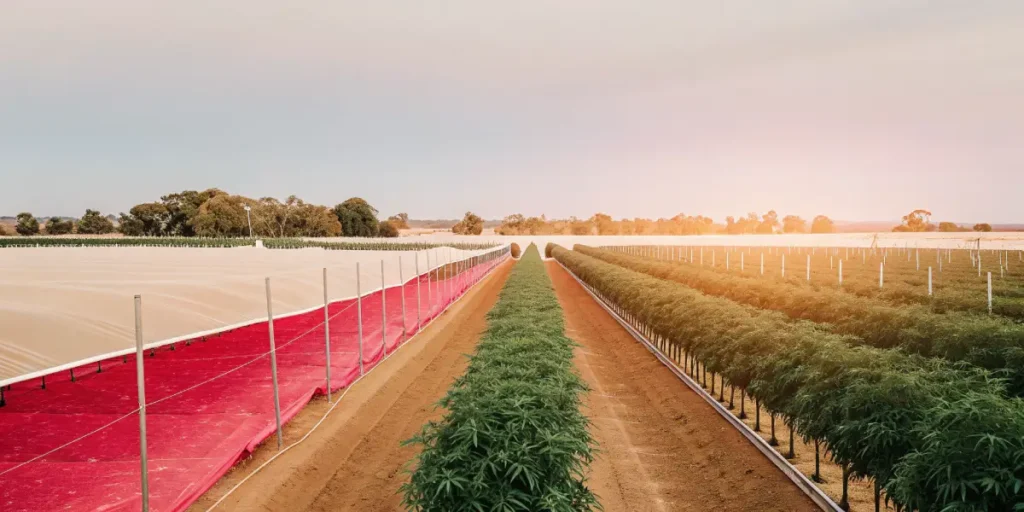
Boosting Cannabinoid Production
To enhance cannabinoid synthesis, control your growing environment meticulously. Maintain optimal temperatures and humidity levels. Trichomes are sensitive to extreme conditions, so stability is key. Excessive heat can degrade cannabinoids, while too much humidity can lead to mold.
Nutrient management is also essential. Providing balanced nutrition supports healthy trichome development. Over-fertilization, however, can harm plants and reduce cannabinoid levels. Regularly monitor plant responses to nutrient changes and adjust accordingly.
Using organic nutrients can sometimes lead to higher cannabinoid production, as they may be more efficiently absorbed by the plant. This aligns with the principles of knowing cannabis plant physiology, where natural interactions often yield the best results.
Pruning techniques and strategic plant training can expose more of the plant to light, thereby improving overall cannabinoid synthesis. Such methods illustrate the importance of knowing the cannabis plant anatomical structure in maximizing the plant’s potential.
Cannabis Plant Nutrient Uptake
Nutrient uptake is a critical aspect of cannabis growth. Roots absorb water and essential nutrients from the soil, supporting overall plant health and development. Macronutrients like nitrogen, phosphorus, and potassium are crucial for various physiological processes.
Micronutrients, though needed in smaller quantities, also play vital roles. A deficiency or excess of any nutrient can lead to growth issues. Observing plant responses and adjusting feeding schedules accordingly can optimize nutrient uptake. Regular soil testing can help maintain the right balance.
Knowing the cannabis plant anatomical structure is vital for optimizing nutrient uptake. The root system’s health directly influences how well a plant can absorb nutrients, making root care a priority for growers seeking maximum yield.
Cannabis plant nutrient uptake can be enhanced by ensuring the growing medium has adequate aeration and drainage. This allows roots to access oxygen and nutrients more efficiently, promoting robust plant development and health.
Managing Nutrient Levels
Effective management of nutrient levels involves knowing cannabis plant physiology and its specific needs at different growth stages. During the vegetative phase, plants require more nitrogen for leaf development. In contrast, the flowering stage demands increased phosphorus and potassium for bud formation.
Overfeeding can lead to nutrient burn, characterized by yellowing leaves and stunted growth. Underfeeding, however, can cause deficiencies, slowing down development. Monitoring plant health and adjusting feeding practices ensures a balanced nutrient supply.
Knowing cannabis plant physiology helps in identifying nutrient deficiencies early. Symptoms such as leaf discoloration or curling can indicate specific nutrient imbalances, allowing growers to make timely corrections.
Utilizing a nutrient schedule tailored to specific strains can optimize growth. Some strains may have unique nutrient needs, and knowing these requirements ensures that plants receive the appropriate nutrition at every growth stage.
Cannabis Plant Growth Stages
Cannabis plants go through several growth stages: germination, seedling, vegetative, and flowering. Each stage requires specific care and conditions to thrive. During germination, seeds absorb water and sprout roots. The seedling stage follows, where the plant develops its first true leaves.
In the vegetative stage, rapid growth occurs as the plant focuses on building a strong structure. The final stage, flowering, is when buds form, and cannabinoid synthesis peaks. Knowing these stages helps in providing the right environment and nutrients at the right time.
Knowing cannabis plant physiology is crucial for tailoring care to each growth stage. Each phase presents unique challenges and opportunities, and addressing these effectively can lead to higher yields and better plant health.
The timing of transitions between cannabis plant growth stages can influence the overall success of cultivation. Monitoring environmental factors and plant signals ensures that these transitions are smooth and beneficial to plant development.
Tailoring Care for Each Stage
Each growth stage demands tailored care. Germinating seeds need a warm, moist environment to sprout. Seedlings require gentle light and a balanced nutrient mix to develop strong roots and leaves. Providing the right conditions from the start sets a solid foundation.
During the vegetative stage, increase light exposure and nitrogen levels to support rapid growth. Train plants to manage height and shape, promoting even light distribution. This stage is crucial for setting up a productive flowering phase.
Knowing cannabis plant physiology helps in identifying the specific environmental conditions each stage requires. From temperature to humidity, each factor plays a role in ensuring robust growth and development.
As plants transition to the flowering stage, adjusting the light cycle to mimic natural seasonal changes can trigger bud development. This knowing of cannabis plant growth stages helps optimize the flowering process, enhancing yield and potency.
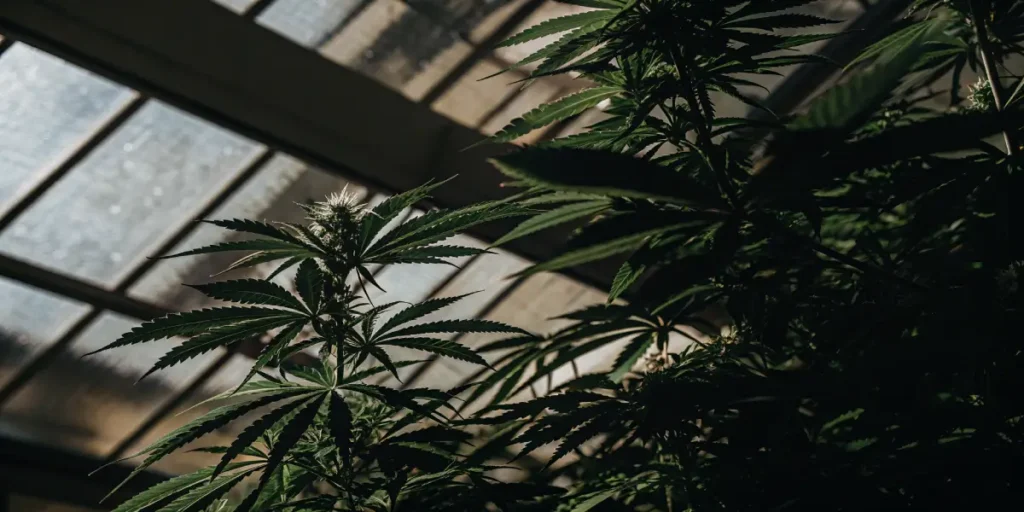
FAQs
What is the cannabis plant anatomical structure?
The cannabis plant anatomical structure consists of roots, stems, leaves, and flowers. Each part plays a vital role in the plant’s lifecycle. Roots anchor the plant and absorb water and nutrients. Stems offer support and transport materials. Leaves are essential for photosynthesis, while flowers are the site for cannabinoid synthesis.
knowing cannabis plant physiology involves knowing how each of these components works together. This knowledge helps in optimizing growth conditions and improving yields. Whether growing indoors or outdoors, recognizing these anatomical features is crucial for successful cultivation.
The cannabis plant anatomical structure also includes microscopic elements like trichomes, which are key to cannabinoid synthesis in cannabis. These structures add another layer of complexity to the plant’s physiology, influencing potency and flavor.
Exploring the cannabis plant anatomical structure can reveal insights into the plant’s resilience and adaptability. Different strains exhibit unique structural traits, providing opportunities to select plants best suited for specific growing conditions.
How does the cannabis photosynthesis process work?
The cannabis photosynthesis process is how the plant converts light into energy. This occurs in the chloroplasts within leaf cells, where chlorophyll absorbs sunlight. The light energy splits water molecules, releasing oxygen and creating ATP and NADPH, which power the conversion of CO2 into glucose.
This process is vital for plant growth and health. Ensuring your plants receive adequate light is critical. Both natural sunlight and artificial grow lights can facilitate effective photosynthesis, impacting the plant’s vigor and productivity.
Knowing cannabis plant physiology includes recognizing how environmental factors affect the photosynthesis process. Proper ventilation and airflow can enhance gas exchange, improving photosynthetic efficiency and overall plant health.
Optimizing the cannabis photosynthesis process involves managing light cycles and intensity. Different strains may have varying light requirements, and knowing these nuances can lead to more targeted and effective cultivation practices.
Why is cannabinoid synthesis in cannabis important?
Cannabinoid synthesis in cannabis is crucial because it leads to the production of compounds like THC and CBD, which have various effects and benefits. These compounds are synthesized in the trichomes of cannabis flowers, influenced by genetic and environmental factors.
Growers can enhance cannabinoid production by managing light, temperature, and nutrient levels. By selecting strains known for high cannabinoid content, such as OG Kush, cultivators can achieve desired effects and maximize yield quality.
Knowing cannabis plant physiology helps in manipulating environmental factors to boost cannabinoid levels. Techniques such as stress training can trigger the plant’s defense mechanisms, leading to increased cannabinoid synthesis.
Cannabinoid synthesis in cannabis also influences the plant’s aroma and flavor profile. By knowing the interplay between genetics and cultivation techniques, growers can produce plants with specific desired traits.
What factors influence cannabis plant nutrient uptake?
Cannabis plant nutrient uptake is influenced by soil quality, pH levels, and the availability of water and nutrients. Roots absorb essential elements, supporting various physiological processes. The balance between macronutrients and micronutrients is critical for healthy growth.
Monitoring plant health and adjusting nutrient schedules based on growth stages can optimize uptake. Overfeeding or underfeeding can lead to issues, so regular soil analysis and observation help maintain the right nutrient balance.
Knowing cannabis plant physiology includes knowing how root health impacts nutrient uptake. Ensuring the root zone remains free of pathogens and pests is essential for maintaining efficient nutrient absorption.
Amending the growing medium with organic matter can improve nutrient uptake by enhancing soil structure and microbial activity. This approach aligns with the principles of sustainable cannabis cultivation, promoting healthier and more productive plants.
How do cannabis plant growth stages affect cultivation?
The cannabis plant growth stages—germination, seedling, vegetative, and flowering—each require specific care. Germination involves seed sprouting, while the seedling stage focuses on establishing roots and leaves. The vegetative stage is about building a robust structure, and flowering is when buds develop.
Knowing these stages allows growers to tailor their care, optimizing conditions and nutrient supply for each phase. This approach enhances plant health, yield, and potency, making it a crucial aspect of cultivation success.
Transitioning between cannabis plant growth stages requires careful monitoring and adjustments. Environmental changes can trigger these transitions, and knowing the signs ensures timely interventions to support plant development.
Each growth stage presents opportunities to optimize specific aspects of plant physiology. By applying targeted care strategies, growers can maximize the potential of each stage, leading to healthier plants and higher-quality yields.



